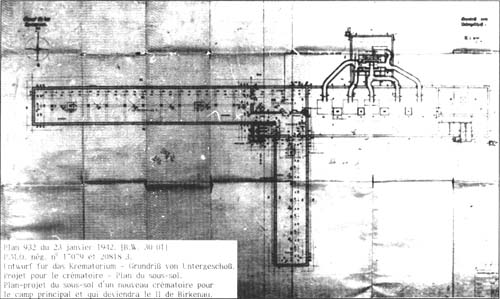
adding a sentence assimilating the ventilation and air extraction system of Leichenkeller I with the air supply to the furnaces:
“For example in the letter of 29th January 1943 quoted at me (a letter not even carrying the usual indication “secret") Vergasung does not mean “gassing”, but “carburetion” [though Butz in fact had suggested “gas generation"!]. Vergasungskeller designates the room where the “gaseous” mixture to fuel the crematorium furnace was prepared. These furnaces, with their air supply and extraction systems, came from Messrs. Topf and Sons of Erfurt (NO-4473).”
Having realized the inconsistency of his argument, a rather more realistic Faurisson, in his “Reply to Pierre Vidal-Naquet”, gave a second version under point 16:
“What V-N calls or baptizes the “gas chamber” of crematorium No. 2 was a “Leichenkeller”, a typical cool room … “A cool room has to be disinfected. For this they used Zyklon B, an insecticide invented in 1917 and still used today all over the world”! [words underlined by the present author].
And so Faurisson, so persnickety about words, became the first person in the history of bacteriology to DESTROY PATHOGENIC GERMS WITH AN INSECTICIDE, forgetting the most common of effective disinfectants, BLEACH. This needs no comment.
Lastly, following my discovery of a “Tagesbericht / timesheet” in which a civilian worker had written that a room in the western part of Krematorium IV was a “Gasskammer / gas chamber”, Faurisson, now with his back to the wall, suggested, a third desperate version in the second edition of the “Reply to Pierre Vidal-Naquet”, page 78: “It is likely that the two rooms found suspect by J-C Pressac in crematoriums IV and V were disinfection gas chambers” [underlined by J-C. P.].
From the translation of “Vergasungskeller” in Krematorium II by “gas generation cellar”, to that of “Gasskammer” in Krematorium IV by “disinfection gas chamber”, there is quite a climbdown. And yet. the sacred axiom still remains unchanged: “homicidal gas chambers never existed”.
From the technical standpoint, a brief examination of the different types of cremation furnaces designed and installed by Topf & Sons [see Part II, Chapter 1] in the Buchenwald, Mauthausen and Auschwitz-Birkenau concentration camps, all of which operated without any kind of gas generation or carburetion [in fact they were coke-fired!], makes it possible to assess at their true value the theories put forward by Butz (a graduate of the Massachusetts Institute of Technology) regarding “gas generation” and Faurisson (literary man and textual critic), with his first legend of “carburetion”, second of “disinfected morgue” [using Zyklon B!] and the final attempt at evasion, “disinfection gas chamber” lwhich should in any case be “disinfestation” to make sense].
The credit for highlighting this letter of 29th January 1943 and using it against the revisionists unquestionably goes to Father G. Wellers, This letter, TAKEN TOGETHER WITH the Prüfer report, provides very important evidence, but does not in itself constitute absolute proof of the existence of a HOMICIDAL gas chamber in the basement of Birkenau Krematorium II.
 |
Document 3 Drawing 932 of 23rd January 1942 [BW 30/01 PMO neg. nos. 17079 and 20818/3] Entwurf für das Krematorium — Grundriß von Untergeschoß / Projected crematorium — basement plan. Originally planned as a new crematorium for the main camp, this building was to become Birkenau Krematorium II |
|
|
|
| Document: 4 Basement part of drawing 932 (above) depicting “Leichenkeller 1, 2 u. 3 / corpse cellars 1, 2 and 3”, and the installations connected with them. |
 |
Translation of inscriptions:
- voir feuille rectificative / plan no 1311!! see correction sheet — drawing 1311 !!]
- LEICHENKELLER 2 / CORPSE CELLAR 2
- LEICHENKELLER 3 Gang / corridor
- Rutsche / [corpse] chute
- Vorraum / vestibule
- Aufzug / [corpse] lift
LEICHENKELLER 1 = VERGASSUNGSKELLER
CORPSE CELLAR 1 = GASSING CELLAR
